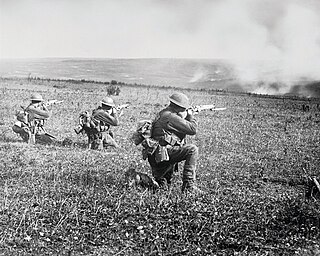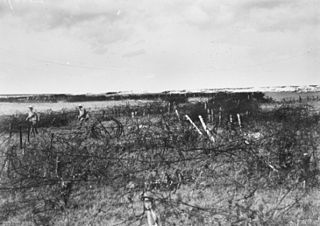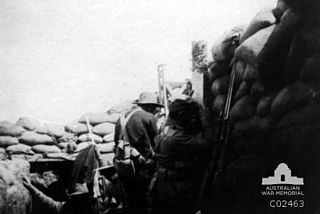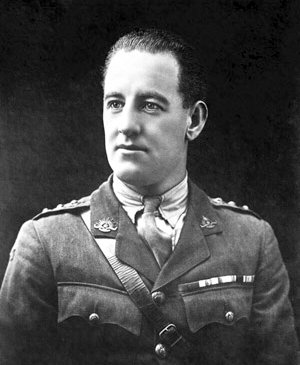The 5th Battalion was an infantry battalion of the Australian Army. Raised in Victoria as part of the First Australian Imperial Force for service during World War I, the battalion formed part of the 2nd Brigade, attached to the 1st Division. It participated in the landing at Anzac Cove on 25 April 1915, coming ashore in the second wave, before taking part in the fighting at Krithia and then at Lone Pine. In December 1915, the battalion was withdrawn from the peninsula and returned to Egypt where it was involved in defending the Suez Canal until being transferred to the Western Front in France in early 1916. After that, over the course of the next two and a half years the 5th Battalion was rotated in and out of the front line and took part in a number of significant battles including at Pozieres, Ypres, Amiens and the Hindenburg Line. Following the end of the war, the battalion was disbanded and its personnel returned to Australia. The battalion was re-raised during the inter-war years as a part-time unit and was later mobilised during World War II, but did not serve overseas. During the post war period, the battalion has existed at various times before being subsumed into the 5th/6th Battalion, Royal Victoria Regiment.

The 6th Battalion was an infantry battalion of the Australian Army. Originally formed in 1914 for service during the First World War, the battalion fought at Gallipoli and on the Western Front. The battalion was disbanded in 1919 but was re-raised in 1921 as part of the Citizens Force, and adopted the title of "Royal Melbourne Regiment" in 1935. The battalion did not serve overseas during the Second World War and was eventually disbanded in 1944. It was re-raised in 1948 and remained in existence until 1960 when it was absorbed into the Royal Victoria Regiment. Today its honours and traditions are maintained by the 5th/6th Battalion, Royal Victoria Regiment.
The 4th Brigade is a brigade-level formation of the Australian Army. Originally formed in 1912 as a Militia formation, the brigade was re-raised for service during World War I, elements of the brigade served at Gallipoli and in the trenches on the Western Front before being disbanded in 1919. In 1921, the brigade was re-raised as a unit of Australia's part-time military forces, based in the state of Victoria. During World War II the brigade served in the New Guinea and New Britain campaigns. Following the war, the brigade formed part of the 3rd Division, however, it was later reallocated to the 2nd Division, where it serves as a Reserve combined-arms formation including units and personnel from all corps of the Army including armoured, infantry, artillery, engineers, signals and ordnance.

The 35th Battalion was an infantry battalion of the Australian Army. Originally raised in late 1915 for service during the First World War, the battalion saw service on the Western Front in France and Belgium before being disbanded in 1919. In 1921, it was re-raised in the Newcastle region of New South Wales as a unit of the Citizens Force. It was subsequently amalgamated a number of times during the inter-war years following the Great Depression, firstly with the 33rd Battalion and then the 2nd Battalion, before being re-raised in its own right upon the outbreak of the Second World War. Following this the battalion undertook garrison duties in Australia before being deployed to New Guinea where they took part in the Huon Peninsula campaign. After the end of the war, the 35th Battalion was disbanded in early 1946.

The 26th Battalion was an infantry battalion of the Australian Army. Originally raised in April 1915 for service in World War I as part of the Australian Imperial Force (AIF), it was assigned to the 7th Brigade and consisted of personnel recruited from the states of Queensland and Tasmania. The battalion fought at Gallipoli in the latter stages of that campaign before being withdrawn to Egypt in late 1915. In mid-1916, it was sent to Europe where it served in the trenches of the Western Front in France and Belgium for the rest of the war, fighting in most of the battles that the Australians took part in between 1916 and 1918. At the end of the war, it was disbanded in May 1919 as part of the demobilisation of the AIF.

The 13th Battalion was an infantry battalion of the Australian Army. Originally raised for the 1st Australian Imperial Force during the First World War, it was formed just six weeks after the start of the war. Along with the 14th, 15th and 16th Battalions which were recruited from New South Wales, it formed the 4th Brigade. The battalion saw service initially at Gallipoli before being transferred to France in 1916. For the next two years it fought in the trenches of the Western Front, earning numerous battle honours in the process.

The 45th Battalion was an infantry battalion of the Australian Army. Raised for service during World War I, the battalion served in the trenches on the Western Front in France and Belgium from mid-1916 until the end of hostilities in November 1918. Following this, it was disbanded in May 1919. Later, in 1921, the battalion was re-raised as a part-time unit of the Citizens Force, based in New South Wales. The battalion remained on the order of battle until 1942, when it was merged with the 1st Battalion as part of a force reduction that was undertaken at that time in response to an over mobilisation of the Australian military in the early part of World War II. In 1948, the battalion was re-raised again and remained on the order of battle until 1960 when it was absorbed into the Royal New South Wales Regiment.

The 32nd Battalion was an infantry battalion of the Australian Army. It was first raised in 1915 as part of the all-volunteer Australian Imperial Force for service during the First World War, and was initially made up of personnel from South Australia and Western Australia. The battalion served in France and Belgium in 1916–1918 before being disbanded in 1919.
The 2nd Brigade was a brigade-sized infantry unit of the Australian Army. Formed in 1903 as a militia formation based in Victoria, the brigade later served during the First World War as part of the Australian Imperial Force, allocated to the 1st Division. During the war, the 2nd Brigade took part in the fighting at Gallipoli, including the Battle of Krithia where it lost almost a third of its strength. Later they took part in the Battle of Lone Pine before being withdrawn back to Egypt in December 1915. Following this the brigade was transferred to the Western Front in France and Belgium where, between March 1916 and the armistice in November 1918, they took part in most of the major Allied operations.

The 10th Brigade was an infantry brigade of the Australian Army. Originally formed in 1912 as a Militia formation, the brigade was re-raised in 1916 as part of the expansion of the Australian Imperial Force following the end of the Gallipoli campaign. It subsequently saw service on the Western Front in France and Belgium during the First World War. After the war it was disbanded but was re-raised in 1921 as a part-time formation based in the state of Victoria. During the Second World War the brigade was used in a garrison role in Australia before being disbanded in 1942.

The 12th Brigade was an infantry brigade of the Australian Army. Formed in 1912 as a Militia formation, it was later re-raised in 1916 as part of the all volunteer First Australian Imperial Force that was raised for overseas service during the First World War. The brigade was part of the 4th Division and fought on the Western Front until the end of the war in November 1918. During the inter-war years, the brigade was re-formed in Australia as a part-time unit; during the Second World War, it was mobilised for full-time service, but did not serve overseas, undertaking garrison duties in Australia until 1945 when it was used to raise Timor Force.

The 58th Battalion was an infantry battalion of the Australian Army. It was raised in 1916 for overseas service during World War I and saw action on the Western Front from June 1916 until the end of the war. Following the end of hostilities it was disbanded in 1919; however, in 1921 the battalion was re-raised as part of the part-time Citizens Force and remained in existence until 1942 when it was amalgamated with the 59th Battalion to form the 58th/59th Battalion. That battalion subsequently saw active service in the Pacific against the Japanese during World War II before being disbanded in 1946. After the war, the battalion was re-formed as an amalgamated Citizens Military Force unit, the 58th/32nd Battalion, which was based in Melbourne. This unit remained in existence until 1960 when it was subsumed into the Royal Victoria Regiment.

The 59th Battalion was an infantry battalion of the Australian Army. Initially raised for service during World War I, the battalion fought on the Western Front in France and Belgium between 1916 and 1918, before being disbanded in 1919. In 1921, it was re-raised as a part-time unit of the Militia in Victoria. They remained in existence until 1942 when, due to a manpower shortage in the Australian economy, the decision was made to amalgamate the battalion with the 58th Battalion to form the 58th/59th Battalion. Together they remained linked throughout World War II, serving in New Guinea and Bougainville in 1943–1945. In 1952, the 59th Battalion was re-raised and subsequently was absorbed into the Royal Victoria Regiment in 1960.

The 55th Battalion was an infantry battalion of the Australian Army. Raised in 1916 for service during World War I in the AIF the battalion served on the Western Front until the end of the war, before being briefly amalgamated with the 53rd Battalion and then being disbanded in 1919. In 1921, the 55th Battalion (militia) was re-raised and in 1927 adopted the title of the "New South Wales Irish Rifles". This designation was later changed to the "New South Wales Rifle Regiment" in 1930, before they were once again amalgamated with the 53rd, forming the 55th/53rd Battalion in 1937. In October 1941, during World War II, the two militia battalions were delinked and the 55th was later deployed to New Guinea, where they took part in the Kokoda Track campaign, fighting against the Japanese. Poorly prepared and trained, and lacking up to date equipment, they performed above expectations; however, they were amalgamated with the 53rd, which had not fared so well, once more in October 1942. The 55th/53rd subsequently took part in further campaigns in New Guinea and Bougainville before being disbanded in May 1946.

The 27th Battalion was an infantry battalion of the Australian Army. It was initially raised in 1915 as part of the all-volunteer First Australian Imperial Force for service during World War I. During the conflict, the battalion saw action briefly at Gallipoli before later fighting on the Western Front between 1916 and 1918. It was disbanded in 1919, but was re-raised in 1921 as part of the Citizens Force, which later became the "Militia". During World War II the battalion was used mainly in a garrison role until the last year of the war when it was committed to the fighting against the Japanese during the Bougainville campaign. Following the end of hostilities it was disbanded in May 1946. Between 1948 and 1965 the battalion was re-raised and disbanded a number of times before eventually becoming part of the Royal South Australia Regiment. It was disbanded for a final time in 1987, when it was amalgamated with the 10th Battalion, Royal South Australia Regiment to form the 10th/27th Battalion, Royal South Australia Regiment.

The 21st Battalion was an infantry battalion of the Australian Army. It was raised in 1915 as part of the First Australian Imperial Force for service during World War I and formed part of the 6th Brigade, attached to the 2nd Division. It fought during the Gallipoli campaign and on the Western Front before being disbanded in late 1918. The battalion was the first Australian battalion to commence active operations on the Western Front and also had the distinction of being the last to pull back when the Australian Corps was withdrawn from the line. In 1921, the battalion was re-raised as a part-time unit of the Citizens Force but was later amalgamated with the 23rd Battalion in 1929 to form the 23rd/21st Battalion.

The 46th Battalion was an infantry battalion of the Australian Army. Originally raised in 1916 for service during the First World War, the battalion served on the Western Front before being disbanded in 1919. It was re-raised as a part-time unit of the Citizens Forces in 1921 and in 1927 adopted the title of the "Brighton Rifles", before becoming part of the Militia in 1929. During the Second World War the 46th served in a garrison role before being amalgamated with the 29th Battalion in August 1942 to form the 29th/46th Battalion.

The 29th Battalion was an infantry battalion of the Australian Army. First formed in 1915 for service during the First World War as part of the Australian Imperial Force (AIF), it fought in the trenches of the Western Front in France and Belgium before being disbanded in late 1918 to provide reinforcements for other heavily depleted Australian units. In 1921, following the demobilisation of the AIF, the battalion was re-raised as a unit of Australia's part-time military forces, based in Melbourne, Victoria, before being amalgamated with the 22nd Battalion in 1930. It was later re-raised in its own right and, following the outbreak of the Second World War, undertook garrison duties in Australia before being amalgamated with the 46th Battalion to form the 29th/46th Battalion in late 1942, subsequently seeing service against the Japanese in New Guinea and on New Britain.

The 37th Battalion was an infantry battalion of the Australian Army. It was originally raised in 1916 for service during the World War I and took part in the fighting in the trenches of the Western Front in France and Belgium and was disbanded in 1918. In 1921, the battalion was re-raised as part of the part-time Citizens Forces, although it was later amalgamated with the 52nd Battalion in 1930 due to manpower shortages. In 1937, the battalion was briefly re-raised in its own right before being amalgamated with the 39th Battalion. It later returned to the order of battle in its own right as the Australian military was expanded due to concerns of a future war in Europe. Following the outbreak of World War II, the 37th Battalion served in a garrison role until 1942 when it was once again amalgamated with the 52nd Battalion.

The 22nd Battalion was an infantry battalion of the Australian Army. It was raised in 1915 as part of the Australian Imperial Force for service during World War I and formed part of the 6th Brigade, attached to the 2nd Division. It fought during the Gallipoli campaign and on the Western Front before being disbanded in 1919. In 1921, it was re-raised as a part-time unit and was merged with the 29th Battalion in 1930 to form the "29th/22nd Infantry Battalion". Split in August 1939 and known as the "22nd Battalion ", the battalion saw action against the Japanese during World War II in the Huon Peninsula and New Britain campaigns. The battalion was disbanded in June 1946. It was re-established as part of the Royal Victoria Regiment in the mid-1960s as a remote area battalion within the Citizens Military Force, and later became a part of the 8th/7th Battalion, Royal Victoria Regiment.

















